8.8E: Exercises
( \newcommand{\kernel}{\mathrm{null}\,}\)
Practice Makes Perfect
In the following exercises, evaluate each function.
- f(x)=√4x−4, find
- f(5)
- f(0)
- f(x)=√6x−5, find
- f(5)
- f(−1)
- g(x)=√6x+1, find
- g(4)
- g(8)
- g(x)=√3x+1, find
- g(8)
- g(5)
- F(x)=√3−2x, find
- F(1)
- F(−11)
- F(x)=√8−4x, find
- F(1)
- F(−2)
- G(x)=√5x−1, find
- G(5)
- G(2)
- G(x)=√4x+1, find
- G(11)
- G(2)
- g(x)=3√2x−4, find
- g(6)
- g(−2)
- g(x)=3√7x−1, find
- g(4)
- g(−1)
- h(x)=3√x2−4, find
- h(−2)
- h(6)
- h(x)=3√x2+4, find
- h(−2)
- h(6)
- For the function f(x)=4√2x3, find
- f(0)
- f(2)
- For the function f(x)=4√3x3, find
- f(0)
- f(3)
- For the function g(x)=4√4−4x, find
- g(1)
- g(−3)
- For the function g(x)=4√8−4x, find
- g(−6)
- g(2)
- Answer
-
1.
- f(5)=4
- no value at x=0
3.
- g(4)=5
- g(8)=7
5.
- F(1)=1
- F(−11)=5
7.
- G(5)=2√6
- G(2)=3
9.
- g(6)=2
- g(−2)=−2
11.
- h(−2)=0
- h(6)=23√4
13.
- f(0)=0
- f(2)=2
15.
- g(1)=0
- g(−3)=2
In the following exercises, find the domain of the function and write the domain in interval notation.
- f(x)=√3x−1
- f(x)=√4x−2
- g(x)=√2−3x
- g(x)=√8−x
- h(x)=√5x−2
- h(x)=√6x+3
- f(x)=√x+3x−2
- f(x)=√x−1x+4
- g(x)=3√8x−1
- g(x)=3√6x+5
- f(x)=3√4x2−16
- f(x)=3√6x2−25
- F(x)=4√8x+3
- F(x)=4√10−7x
- G(x)=5√2x−1
- G(x)=5√6x−3
- Answer
-
1. [13,∞)
3. (−∞,23]
5. (2,∞)
7. (−∞,−3]∪(2,∞)
9. (−∞,∞)
11. (−∞,∞)
13. [−38,∞)
15. (−∞,∞)
In the following exercises,
- find the domain of the function
- graph the function
- use the graph to determine the range
- f(x)=√x+1
- f(x)=√x−1
- g(x)=√x+4
- g(x)=√x−4
- f(x)=√x+2
- f(x)=√x−2
- g(x)=2√x
- g(x)=3√x
- f(x)=√3−x
- f(x)=√4−x
- g(x)=−√x
- g(x)=−√x+1
- f(x)=3√x+1
- f(x)=3√x−1
- g(x)=3√x+2
- g(x)=3√x−2
- f(x)=3√x+3
- f(x)=3√x−3
- g(x)=3√x
- g(x)=−3√x
- f(x)=23√x
- f(x)=−23√x
- Answer
-
1.
- domain: [−1,∞)
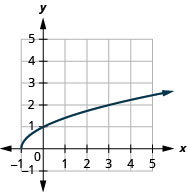
Figure 8.7.8- [0,∞)
3.
- domain: [−4,∞)
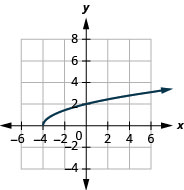
Figure 8.7.9- [0,∞)
5.
- domain: [0,∞)
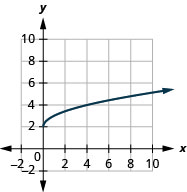
Figure 8.7.10- [2,∞)
7.
- domain: [0,∞)
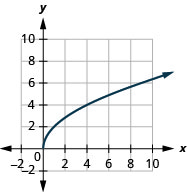
Figure 8.7.11- [0,∞)
9.
- domain: (−∞,3]
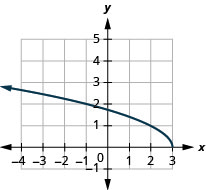
Figure 8.7.12- [0,∞)
11.
- domain: [0,∞)

Figure 8.7.13- (−∞,0]
13.
- domain: (−∞,∞)
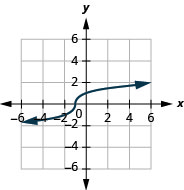
Figure 8.7.14- (−∞,∞)
15.
- domain: (−∞,∞)
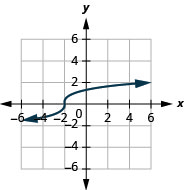
Figure 8.7.15- (−∞,∞)
17.
- domain: (−∞,∞)
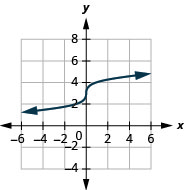
Figure 8.7.16- (−∞,∞)
19.
- domain: (−∞,∞)
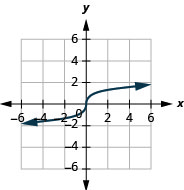
Figure 8.7.17- (−∞,∞)
21.
- domain: (−∞,∞)
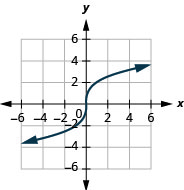
Figure 8.7.18- (−∞,∞)
- Explain how to find the domain of a fourth root function.
- Explain how to find the domain of a fifth root function.
- Explain why y=3√x is a function.
- Explain why the process of finding the domain of a radical function with an even index is different from the process when the index is odd.
- Answer
-
1. Answers may vary
3. Answers may vary
Self Check
a. After completing the exercises, use this checklist to evaluate your mastery of the objectives of this section.

b. What does this checklist tell you about your mastery of this section? What steps will you take to improve?


